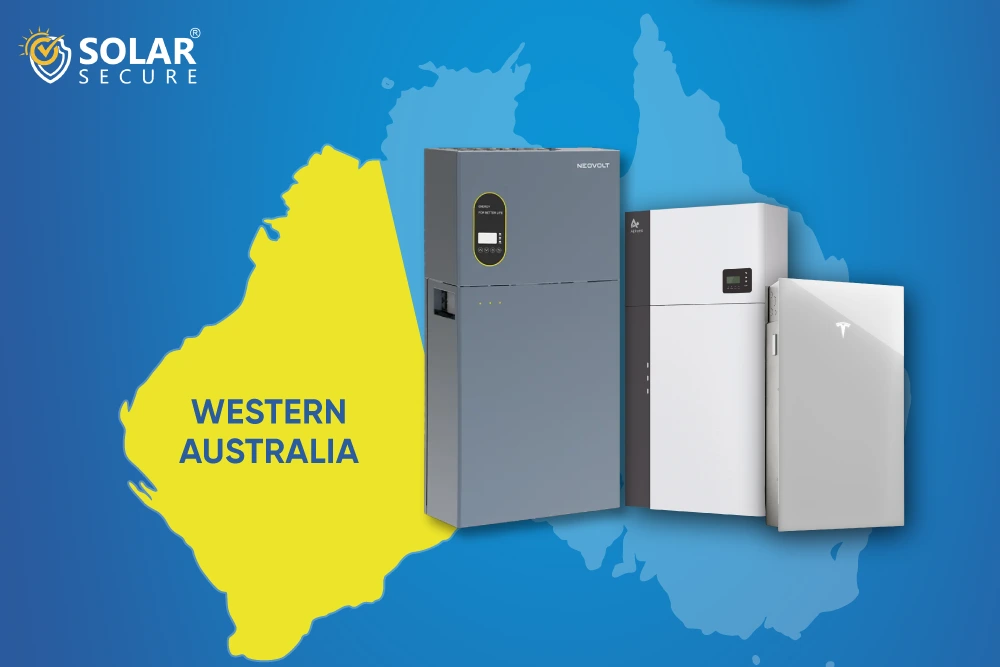The Western Australian government has promised a WA Home Battery Rebate from 1st July 2025 if re-elected. The scheme includes a rebate, plus an interest-free loan to finance the cost, but actual details are currently limited.
Western Australia’s Government has pledged substantial subsidies for home battery installations if re-elected.
With the WA State Election set for Saturday, 8th March 2025, both major parties officially launched their campaigns over the weekend. A key voter demographic is the state’s solar system owners, with more than half a million small-scale rooftop PV systems installed in the state to date.
Premier Roger Cook has committed to a $387 million initiative, offering one-time home battery rebates of up to $5,000 for Synergy customers and up to $7,500 for Horizon Power customers, if current government regains power.
According to Mr. Cook, this program could add more than 200 megawatt-hours of storage to WA’s electricity grid equivalent to approximately 20,000 batteries with 10 kWh capacity. As of mid-last year, around 10,000 residential batteries had been installed across the state.
While full details are yet to be disclosed, key points of the scheme include:
- Rebates will be scaled based on battery capacity.
- Batteries must comply with Australian and local grid regulations.
- Recognized brands and locally manufactured batteries will be eligible.
- The program is set to commence on 1st July 2025.
What Do We Know About the WA Home Battery Rebate?
Rebate
Up to $5,000 for Synergy customers, and up to $7,500 for Horizon Power customers, but the actual rebate will be determined by the size of the battery.
Interest-free Loans
For the remaining cost, zero interest loans up to $10,000 for 20,000 low and medium-income households.
Eligibility
The only conditions released so far are.
- 1. The batteries must meet Australian and local grid standards.
- 2. The batteries can include existing recognised brands as well as locally manufactured batteries.
- 3. For loans households will be means-tested to help low and medium-income households.
Number of Rebates Available
The only details released so far are :
- 1. The total pledged for the scheme is $387 million. However, this needs to cover the cost of the rebates, interest-free loans and an additional $50 million for local battery manufacturing.
- 2. The pledge states “it anticipated the Scheme will more than double the number of residential batteries currently installed in WA homes”. Assuming there are about 15,000 batteries installed already, therefore around 20,000 homes could benefit, but it’s not clear yet what the funding rollout timeline will be.
How Affordable Will the Scheme Make Batteries for WA Homes?
Typical, batteries cost between $10,000 and $15,000. Therefore, the combination of the rebate and interest-free loan could significantly lower the financial barrier for homeowners.
Here are our estimates based on the details announced so far :
- Upfront Cost : Assuming a $15,000 battery gets the maximum $5,000 rebate, the out-of-pocket price for the battery would reduce to $10,000.
- Remaining Costs :20,000 households also get an interest-free loan to finance the entire remaining $10,000, therefore making it $0 upfront cost.
- Payback Period : Government estimates a solar battery will save WA households up to $1,500 per year. Therefore, depending on your electricity usage patterns, you could see a payback period as low as 6 to 7 years.
- Cash Flow : Monthly loan repayments may be offset by electricity bill savings, improving affordability.
Why Is Government Proposing a WA Home Battery Rebate?
Besides a catchy election promise, the WA Home Battery Scheme aims to address the electricity system’s challenges :
- High rooftop solar uptake : WA has one of the highest rates of rooftop solar in Australia, which creates grid management issues, especially during daytime solar generation peaks.
- Rising electricity costs : Households are seeking ways to reduce their home expenses.
- Grid reliability concerns : The scheme aims to reduce pressure on the grid during peak demand periods.
WA Government has positioned the scheme as both a cost-of-living relief measure and to help the grid decarbonise, so a step toward a more sustainable, reliable electricity system.
Scheme eligibility criteria and requirements
While detailed terms and conditions for the battery scheme are still to be finalised in consultation with industry, some of the key eligibility criteria and requirements are outlined below.
Eligible applicants
- 1. Residential properties in Western Australia, including home business customers are eligible.
- 2. Property must be subject to a residential electricity account with Synergy or Horizon Power.
- 3. Excluded residential properties include those owned by State, Commonwealth or Local Government entities, banking and financial institutions, telecommunications companies, and mining/resources companies.
- 4. Rebates and loans will be limited to one per property connection – an additional rebate will be available for landlords who can demonstrate a long-term tenancy agreement.
- 5. While rebates will be available to all eligible households, loan eligibility will be limited to households falling below a specified income threshold. The limit is to be determined by government.
- 6. Minimum loan amount will be $2,000.
Eligible battery systems
- 1. New, additional and replacement battery systems, with minimum 5kWh storage capacity will be eligible. New, additional and replacement solar panels will also be eligible for loan funding assistance where they are installed as part of a package involving installation of a battery system. Further detail of the minimum sizing of eligible solar systems is to be developed in consultation with industry.
- 2. Battery systems will need to demonstrate Virtual Power Plant readiness, i.e. that the system can connect to the electricity grid and respond to signals. This readiness will also include a requirement for an ongoing internet connection, with regular testing.
- 3. Further minimum standards and system warranty provisions are to apply. These requirements are to be developed in consultation with industry.
Retailer and installer requirements
- 1. Retailers and installers must have a Western Australian address for their business.
- 2. Financial and integrity standards must be continuously met.
- 3. Previous pricing is to be published ahead of each round of rebates for full disclosure. Pricing disclosure arrangements are to be developed by the scheme administrator.
- 4. Retailers and installers will be required to demonstrate capacity to deliver in order to participate in the scheme and continue to demonstrate ability to meet technical and safety standards, including being subject to compliance audit testing. Further details of accreditation and compliance arrangements are to be developed in consultation with industry.
Wider Advantages of Home Battery Adoption
Even those who can’t or choose not to install home batteries may still gain from programs encouraging their deployment.Even those who can’t or choose not to install home batteries may still gain from programs encouraging their deployment.
Among the broader community benefits of home batteries :
- Improved grid stability.
- Reduced pressure on the grid during peak times, helping delay or avoid costly infrastructure upgrades.
- Lower wholesale electricity prices, especially during peak usage periods.
- Enabling participation in Virtual Power Plants (VPPs), which can absorb excess solar power and support the grid.
- Contributing to Australia’s renewable energy storage as coal plants are phased out.
How to Prepare for the WA Battery Rebate
Rebate demand will likely exceed supply. Follow these steps to be installation-ready before the rush.
1. Install Solar (or Plan to Bundle)
Homes with existing solar will be in a stronger position to qualify. If you don’t already have panels, install them now or bundle them with a battery to maximise savings.
2. Choose a Hybrid Inverter
A hybrid inverter supports both solar input and future battery integration. It simplifies system expansion and avoids delays tied to grid approval.
- DC-coupled systems integrate faster.
- Hybrid setups reduce install time when batteries are added later.
3. Pre-Order Your Battery
To secure stock and fast-track compliance, pre-order your battery in advance. With only 20,000 rebates available, early preparation ensures you’re at the front of the line.
4. Work With a Trusted WA Installer
The rebate requires WA-based installers — but a local company also offers :
- Faster turnaround.
- Localised aftercare and warranty support.
- Knowledge of WA compliance standards.
Avoid national operators chasing rebate programs. Choose a provider with proven experience in WA like Solar Secure.
Conclusion
The WA Home Battery Rebate, introduced under the current Government, is a clear example of policy in action that balances household affordability with long-term environmental goals. By supporting families and homeowners to invest in home battery storage, Government is not only helping to lower power bills but also accelerating Western Australia’s clean energy transition.
This rebate is part of a broader government commitment to renewable energy, grid innovation, and climate resilience. It reflects the government’s belief that everyday Australians should benefit from the shift to cleaner energy and not just big businesses. With this program, more households can store their excess solar energy, reduce reliance on the grid during peak times, and contribute to a more stable, sustainable electricity network.
Importantly, this initiative doesn’t just benefit battery owners. By relieving pressure on the grid and supporting the growth of Virtual Power Plants, the entire community reaps the rewards through lower wholesale electricity prices, fewer blackouts, and deferred infrastructure costs.





